1/48 Scale Monogram De Havilland Mosquito Mk IV FB
My second RAF Aircraft, and boy was this one strange. I started this aircraft almost 5 years ago, and I have just now finally got it done (Of course, I have moved twice since I started this poor thing).
I also call this aircraft the plane that did not want to get built. I have more problems in assembling this model than all the other I have done so far. More on that later. Also, this aircraft is one of the few older Monogram kits that I had never built before; therefore, it was a little bit of a learning experience. For right now, on to the build.
In the Beginning
Opening the box, you will find that you can build up to 4 different variants of the MK IV Mosquito: Fighter Bomber, Bomber, Night Fighter, and regular Day Fighter. The fighter-bomber version also includes under wing rockets for Fleet Air Arm Mossies. This kit is an early 2000's reissue, which was molded in grey styrene, but the props, additional ordnance, and some of the cockpit sections were molded in black. This a little different in that it has recessed panel lines, quite unusual for a vintage era kit. After inspection, and cleaning, the fun began.
Main Assembly
You have to decide right off the bat if you are going to build a bomber, or one of the three fighter versions. If you want to build the fighter, then you are going to have to cut off a portion of the nose, since the kit is molded as a bomber. I wanted to build this one as a fighter-bomber, so I removed the bomber nose. Monogram made this quite bit easier by molding in a scoring line where the nose needs to me removed, and the plastic in the area is thin. I had no problem using just my Exacto knife to do this. After the nose section was removed, I sanded the area smooth. I then assembled the cockpit (be aware that there are two different joysticks, one for the fighter version and one for the bomber version. I had no idea about this, and I got it right by chance). There really is not a whole lot to the cockpit, so assembly was quick. After this, the cockpit was painted British Interior Green and installed, and then tail wheel assembly was glued in, and the surrounding tail wheel area was also painted British Interior Green. After all of this was done, the fuselage was cemented together.
While the fuselage was firming up, the wings were put together, and this is where I did not do my homework properly. I had originally wanted to do a rocket armed fighter-bomber, but I had not realized at the time that many rocket armed Mossies were Fleet Air Arm, so I opened the holes in the bottom of the wings for the rockets. But I then later painted the model in RAF colors which was different from Fleet Air Arm colors. One of many screw ups on this build. The wings were then attached to the fuselage, as well as the stabilizer fins. I then painted the main wheel wells British Interior Green, and installed the main landing gear. The model then got put aside for well...about five years.
Shooting ahead 5 years, and two house moves later, I decided to finally finish this bird. Most of the assembly had been done as described above, but somehow during the two moves, one of the linkages for the bomb bay doors had been lost, and I, for whatever reason, decided to make a new one of the sprue that the parts were attached to instead of opening one the 3 other Mossie kits I have, and use one of those. It came out OK, but it does look different.
Paint and Decals
I decided to do this bird as a fighter-bomber, but I had never really done an Mossie camouflage scheme before, so I did a little research, and I am glad that I did. Apparently, RAF camo schemes for bombers and fighters are different. For example, I used British Dark Green, over British Medium Grey for the uppers, and British Ocean Grey for the lower areas. But on the bombers, the RAF reversed the upper colors, so for example, looking at my Mossie from the tail, you will see from left to right on the upper wings British Medium Grey, then the British Dark Green. On bombers, this was reversed, so you would see British Dark Green, then the British Medium Grey. This was a little confusing. I was making a fighter- bomber, so which was it to be? Per my research, it looked like this bird should be painted in the fighter scheme, so that is what I did.
On the upper surfaces, I laid down the British Medium Grey with brush and qtip, then I wondered how I was going to do the British Dark Green, since the demarcation lines on the camo scheme that RAF aircraft used did not have a soft edge on the upper sections, but neither was it super hard edged either, so you really could not use masking to do this. The idea I came up with was to rough out the area for the Dark Green by using a qtip, which made a soft edge. Then I used a Point 0 Round Brush to make the actual demarcation line between the two colors. By and large, this worked out good because the British aircraft were painted by masking off the areas to be painted by a mat, which would give you a semi hard edge. All this was done freehand. After the upper surfaces were done, I then masked the fuselage to paint the lower surface. Generally, on aircraft the lower surface painting is done first, but like most British aircraft of this period, the lower surface paint cut across the upper colors. After this was masked, I painted the lower surfaces British Ocean Grey. All the paint I used on this kit were from Pollyscale.
Now, as I previously stated, I had wanted to do a rocket armed fighter-bomber, but the colors, and it turned out later, the decals, were all wrong, so I went with an RAF fighter-bomber instead. I now, however, had to fill in the holes that I had drilled out 5 years before for the rocket rails. I did this by using body putty and white glue. It came out OK, but not the best. I managed to hide a lot of it with weathering. After numerous touch ups for the upper wings and fuselage, I laid down a layer of Glosscote straight out of the can for the decals.
The decals I used were the Eagle Strike Decals Mosquito, Best Sellers, pt. II. The aircraft I choose to model was “Hairless Joe” of 418 squadron, which was a Canadian unit that was based in England. The decals went down great, with no big issues at all, and all reacted good with Microset and Microsolve. After letting the setting solutions do their magic, and I was happy with everything, I laid down a layer of Dullcote, again straight out of the can.
Weathering and Final Assembly
I faded the upper parts of the aircraft with my usual method of a wash of flat white, then I did the usual paint chipping along the leading edges and high wear areas. I also did the dry brush weathering along the panel lines, and on the decals to tone them down a little bit. I did not go to heavy on the weathering, since all the RAF aircraft pictures I have seen of Mossies have showed them to be well maintained. It was at this stage that things began to get a little frustrating.
For starters, the bomb bay door that I created a linkage for would not stay on, and because the homemade link was made from a piece of sprue, it would not allow the door to sit properly on the lower fuselage. I did finally get it to stay, but it is still not lined up that way I would like it to be. The second issue was the nose guns. I do not know how this happened, but one of the 2 middle nose gun barrels broke off (but all the others stayed in place). Luckily, I did find the barrel, but now I had to butt fit the barrel to the remainder of the gun, and the remainder was just inside of the fuselage! The last major frustration was, as usual, the canopy lines.
This aircraft has a two-tone camouflage scheme, which happens to run right up to and across the canopy. I did paint the canopy lines Interior British Green first, I then attempted to paint the two-color schemes to match up with the camouflage lines on the upper surface. No matter what I did, the British Medium Grey just did not look right. In the end, I just painted all the canopy lines British Dark Green, and it does look much better.
After all the weathering, and last minute touch ups, something was still missing. It took me awhile to figure it out, until one day I was looking at my reference material one last time, and it dawned on me that I did not have the under-wing “slipper” drop tanks installed. At this point, I just wanted to get this thing done, but I assembled the tanks, dirtied them up a little bit, and installed them using Microscale Krystal Kleer.
Conclusions
Even though I have expressed a lot of frustration with this kit, I like the way it came out. A lot of these issues were due to a 5-year hiatus in between starting and finishing, and my unusual lack of doing proper research. But the kit came out pretty good, and it is a big model. I am very pleased with the way the camo scheme came out, and I am now ready to do more RAF aircraft.
I also like that you can do several different variants of the Mossie with this kit, and I am now looking forward to doing a Fleet Air Arm bird, in the correct colors!
Until next time…
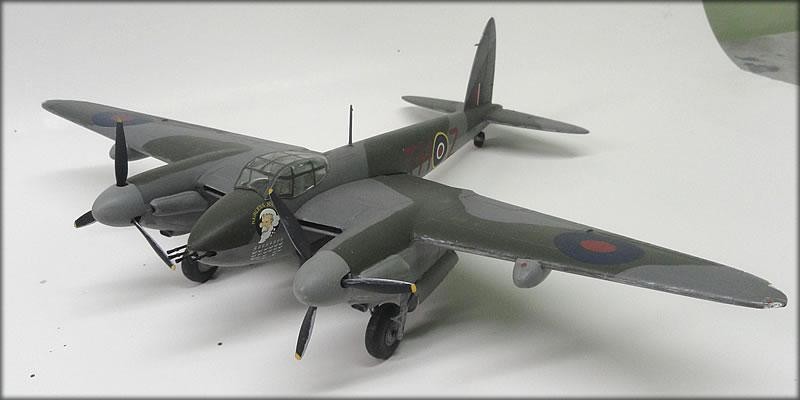
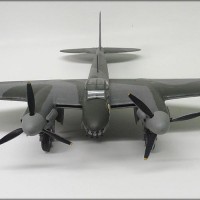
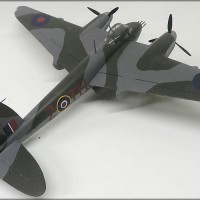
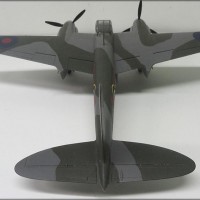
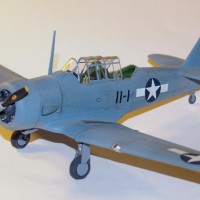

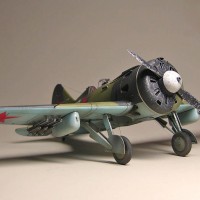
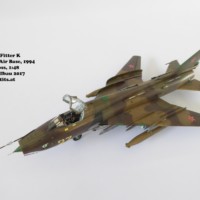
The Mosquito (or the wooden wonder as it was called) was a beautiful and elegant plane.
There was a lot of vintage kits on it, but not so many nowadays, which I can't understand...
Never tried one in 1/48, but enjoyed much doing one (from the 1970's) in 1/72.
Nice build!
Great job on your old Mossie, Kipling! I have the same kit, only mine is the original issue from the 1970s, not a re-issue. As I recall, it was one of Monogram's first issues that paid attention to panel lines and (at least on other kits) rivets.
Well done!
Actually, the original issue was 1963. I bought one while home on leave after my first WestPac deployment.
Thanks, Tom. I didn't realize it was that old. Although we (Dad & I) had one of these kits likely when they first came out, I didn't buy this one quite that early.
Well...despite all the "frustrations" encountered, it certainly turned out well.
Nice looking Mossie!
Hi, Kipling. Very well done. If you haven't already, give the 1/48 Tamiya Mossie's a go.
Beauty